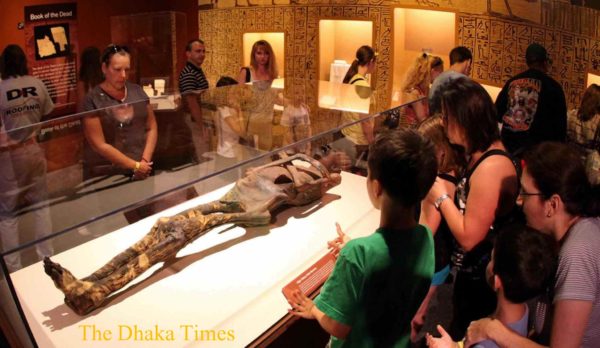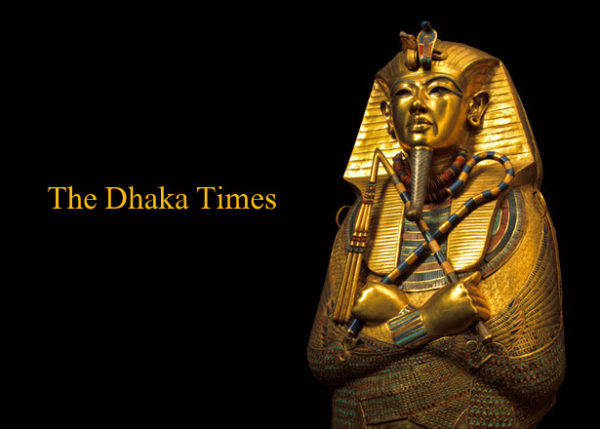The Dhaka Times Desk What is the history behind making mummies? Is it really so shocking? Or a terrible reawakening of souls! Or mummy thousands of years old ancient Egyptian life and culture! Or is it a Hollywood blockbuster where dead mummies come back for revenge and wreak havoc on the world? Whatever the reason, mummies and their stories are an essential part of history.

So far many people have dedicated their lives through research to uncover the mysterious answers that the ancient Egyptians left behind. By studying mummies, historians have been able to learn about the lifestyle, economy, culture, beliefs and more of the ancient Egyptians.
Real mummy stories are similar, but Hollywood mummy stories are made entertaining for the needs of movies. But the stories behind Hollywood movie stories are somewhat true.

Meanwhile, historical research shows that a mummy whose brain was removed at the beginning. The brainless body of the mummy is wrapped in cloth and buried inside the pyramid in a novel arrangement of the era. However, beyond the normal rules, many processes have to be completed to turn the dead body into a mummy. Mummification is not just about placing the body somewhere but is a painstaking, complex and lengthy process that is an important part of ancient Egyptian religion. Here we look at how and why embalming was an important part of ancient Egyptian religion and the process of embalming.

Ancient Egyptian religion was polytheistic meaning they believed in many gods. Ancient Egyptians believed in life after death. Human souls were judged in the underworld (Tut) where they were received for judgment. The two main gods of Tut are one known as "Ra" who is the sun god and the other as "Osiris" the god of the underworld. Before entering Tu, the underworld, all dead souls were judged by the gods.

Osiris, after being killed by Seth, was brought back to life by the magic and power of the goddess Isis. Through this resurrection, both Isis and Osiris could inherit the earthly world together, but Osiris lost the earthly kingdom through death. On the other hand, he appeared as the god of the underworld. Osiris judged souls based on their good deeds, charity, piety, funeral rites, faith in words, and prayers. Many, especially the poor, who could not afford to perform such funerals, were also subjected to cruel punishments. Among the many levels of Tut, they were admitted to the very first level. Haters and worshipers of the gods were punished with fiery stones. Before Osiris punished them with stones, his goddess Nephis inflicted brutal punishment on them.

Ra, the sun god and creator of the ancient Egyptians, entered the eastern horizon of Tut by boat, armed with a guard of spirits. The devout souls who came in the boat with the god Ra were considered the inhabitants of heaven and the detractors were sent to hell for punishment. Ra used to carry the souls with him at night in Tut to protect them from various evil hands. He would set them free at sunrise until sunset in the eastern horizon of heaven. The Egyptians believed that this is why the sun rises and sets. Ra carried the sun along with the souls. Ra's morning boat was called "Metit" meaning be strong and his night boat was called "Sematit" meaning be weak. The gods used to bring the soul and the sun to the heavens on his torch, resulting in the sunrise. And the soul and the sun were carried together, resulting in sunset and night. When the gods roamed the underworld at night, he felt joy at the peace of souls.
The ancient Egyptians believed that preserving their bodies after death was important to benefit the souls in the afterlife. "Khat" or body meant the soul resides there. The soul has many abstract personalities. “Ka” (mind) abode the body means “khat” which is originally held in the body by the deity from heaven. On the other hand "Ba" (soul) "Khaibit" which is the mental body and "Sekham" or soul's vitality descends to the underworld or Tu before Ra and Osiris for judgment. All spiritual bodies are interconnected and interdependent. Because these spirits depend on each other freely through food, drink, and objects, which mainly manifest as gems, weapons, furniture, and chariots, they are buried with the corpse. In some tombs, additional rooms were made for offerings, so that the souls would not be in short supply of food and drink. After the body was buried, the entire room was decorated in various styles and paintings as it was believed to give a taste of the reality of souls in the afterlife. Prayers, mantras and religious carvings took place in the composition and painting.

Mummification of the physical body was a major part of Egyptian religion. This process of mummification gradually evolved. Historically it was a shallow burrow in the desert to protect it from the heat and mud. Later, the upper class Egyptians thought of the method of burial by building an ax. It thrives well when the need for conservation increases from a religious perspective. Advanced mummy making began around 2600 BC. The first and most advanced but expensive procedure is to forcefully remove the brain from the head with a bent iron rod and gently wash the nose and skull with a drug. Then the belly is cut and washed with palm wine and perfumed. Also the stomach cavity is left by various myrrh products. After the corpse is thoroughly cleansed, the body is wrapped from the soles of the feet to the head with a linen cloth covered with fragrant glue. Then after a few days the dead body is transferred to the mortuary with respect. The mortuary is made in the shape of human body. The second cost is after transfer to the mortuary, cedarwood oil is injected into the abdomen through a syringe. It melts all the organs and flesh inside the stomach except for the skin and bones. In the third stage of embalming, the intestines are removed and the body is completely covered with embalming. Thus ending the mummification process, the corpse is buried in a secret vault.

Historians and researchers believe that the way of life of the ancient Egyptians was a combination of devotion to the gods, somatic prayer, imagination of the afterlife and moral perspective. The Egyptians showed us that death is a point of transition between mortality and immortality. Where at one level they would prepare for the next level, they believed they had to be with God in the afterlife, a life that had no end.
Main sources: Humanities360


